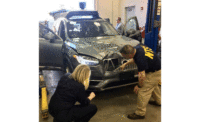More bicyclists die on U.S. roadways in crashes with motor vehicles than the deaths resulting in railroad, marine or aviation accidents1, according the National Transportation Safety Board (NTSB), which has taken up the subject of bicycle safety for the first time in 47 years.
The 806 bicyclists who died in crashes in 2017 got the NTSB’s attention; so did the fact that bikes are increasingly being used a means of transportation.
New NTSB research updates our understanding of bicyclist safety in the United States by examining the prevalence and risk factors of bicycle crashes involving motor vehicles on US roadways and assessing the most applicable countermeasures.2
They're vulnerable road users
Bicyclists, like pedestrians and motorcyclists, are considered vulnerable road users because they are unprotected by an enclosed vehicle compartment, leaving them more vulnerable to injury or death in the event of a crash. In 2018, the NTSB issued reports addressing pedestrian and motorcyclist safety, and with this safety research report on bicyclist safety, the NTSB again expands its effort to increase awareness of and address safety issues affecting vulnerable road users (NTSB 2018a, 2018b). To conduct this research, the NTSB used the following combination of quantitative and qualitative methods: reviewing countermeasures and research literature; analyzing crash and injury data; and interviewing national, state, and local traffic safety stakeholders. The research goals were to (1) describe fatal and nonfatal injury trends associated with bicycle crashes involving motor vehicles, (2) examine the scope and nature of bicyclist crash and injury risk factors and assess data limitations, (3) identify proven countermeasures that may be underused, (4) assess obstacles that may interfere with the full use of the identified countermeasures, and (5) explore emerging issues that are relevant to bicycling safety.
Focus is on bicycle-motor vehicle crashes
Bicyclists involved in crashes with motor vehicles are more likely to sustain severe injuries than bicyclists involved in any other crash type. As a result, this research focuses on bicycle crashes involving motor vehicles and specifically examines existing and emerging countermeasures designed to improve bicyclist safety on public roads, such as roadway and infrastructure designs to separate bicycles from motor vehicle traffic; rider and bicycle conspicuity enhancements; vehicle technologies designed to reduce collisions between motorists and bicyclists when they are sharing the road; and protective equipment for reducing the severity of injuries to bicyclists involved in crashes with motor vehicles. Single-bicycle crashes and bicycle collisions with pedestrians are not addressed; however, many of the safety countermeasures examined have the potential to prevent other bicycle crash types or reduce injury severity.
- In 2017, 761 people died as a result of railroad accidents, 694 people died as a result of marine accidents, and 350 people died as a result of aviation accidents.
- Additional information about this safety research can be found in the NTSB Docket Management System, using the NTSB ID DCA18SS002. For more information about NTSB safety recommendations, see the Safety Recommendation Database at www.ntsb.gov.






